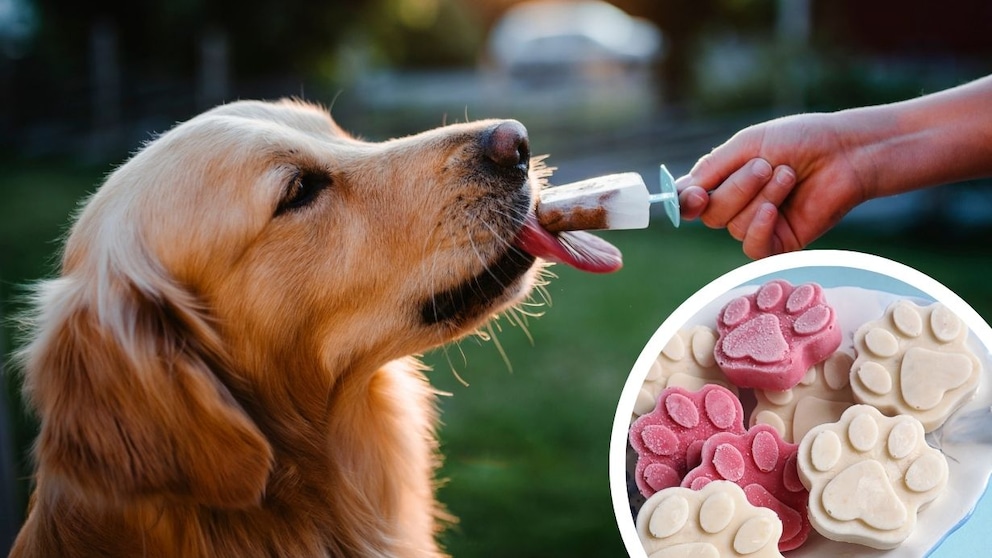
September 2, 2024, 8:30 am | Read time: 3 minutes
Dogs love ice cream, too – and not just in summer. Unfortunately, in addition to sugar, ice cream also contains ingredients that dogs cannot tolerate or that are even poisonous to them. Fortunately, dog ice cream can be made from healthy ingredients and is still delicious.
If you want to treat your four-legged friend to a cool snack, you should definitely try making your own dog ice cream. You don’t need an ice cream machine or expensive ingredients. The following four recipes for dog ice cream should serve as inspiration. You can adapt them to suit your four-legged friend’s taste. We hope you enjoy making them!
Carrot and cheese ice cream
This ice cream contains no dairy products and tastes good for dogs who love carrots. Ice cube molds are used for freezing. You should adapt these to the size of your dog. In addition to the classic ice cube molds, you can also use silicone molds. The ice is also particularly easy to remove from these.
Ingredients:
- 100 g cooked or raw (grated) carrots, alternatively other vegetables such as spinach, potatoes or cauliflower are also suitable
- 100 g grated cheese
Preparation:
- Fill the ice cube molds halfway with the grated cheese, pressing the cheese down a little.
- Fill the molds with the vegetables and place them in the freezer for at least three hours.
Oatmeal mango ice cream
This dog ice cream recipe is suitable for the sweet-toothed among our four-legged friends. As an alternative to mango puree, which is conveniently available in a can, you can also use other types of fruit and puree them.
Ingredients:
- 8 tbsp rolled oats
- 8 tbsp buttermilk
- 4 tbsp mango puree, alternatively banana, pineapple, or strawberries are also suitable
Preparation:
- Puree the fruit if necessary.
- Mix the ingredients and pour into an ice cube mold.
- Place in the freezer for approx. 90 minutes.
Yogurt and fruit ice cream
Self-filling ice cream molds are particularly suitable for this ice cream. If you don’t have any, you can also fill small yogurt pots or plastic containers and freeze them – our dogs don’t need an ice cream stick to eat it anyway.
Ingredients:
- 6 tbsp natural Greek yogurt
- 4 tsp chia seeds
- Apple, alternatively strawberries, banana, or melon are also suitable
Preparation:
- Leave the chia seeds to swell in water for approx. 15 minutes (follow the instructions on the packet).
- Mix the swollen chia seeds with 2 tbsp yogurt.
- Fill the ice cream molds one-third full with the yoghurt-chia mix.
- Wash and finely dice the fruit, then mix about two-thirds with the remaining yogurt and puree with a hand blender.
- Fill the ice cream molds with the yogurt and fruit mix. Spread the remaining fruit into the molds. This ensures a varied consistency in the ice cream, which many dogs appreciate.
- Place the ice cream in the freezer for at least two hours.

A health consultant explains No more cat food in the house? Here is an alternative you could feed your cat

Fruity snack Which fruits are dogs (not) allowed to eat?

Cucumber, pumpkin, zucchini … Can cats eat vegetables?
Chicken quark ice cream
This recipe for dog ice cream is also suitable for four-legged friends who need a low-sugar or low-calorie diet. Depending on the recipe, you can use low-fat quark or other fat levels. It is also best to use small ice cream molds or other containers for filling.
Ingredients:
- 100 g chicken (boneless), alternatively lean beef, or fish is also suitable
- 5 tbsp quark
- some cooking water (stock)
Preparation:
- Cook the chicken until it is done. Do not use any salt!
- Remove the chicken, cut it into small pieces, and puree it with a little of the cooking water.
- Mix the quark with the chicken puree and pour into ice cube molds or small ice molds.
- Place the chicken and quark mixture in the freezer for at least two hours.

